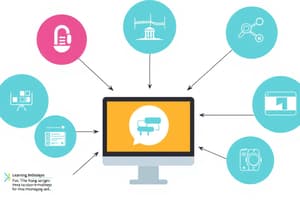Podcast
Questions and Answers
What is the primary goal of conducting a learning needs analysis?
What is the primary goal of conducting a learning needs analysis?
- To develop standard training materials regardless of context
- To identify gaps between current and desired knowledge, skills, and competence (correct)
- To evaluate the current knowledge of stakeholders without further action
- To create a one-size-fits-all solution for training
Which of the following is NOT a typical feature of a learning needs analysis?
Which of the following is NOT a typical feature of a learning needs analysis?
- Identifying critical learning needs
- Implementing training without stakeholder input (correct)
- Gathering data from stakeholders
- Establishing clear evaluation criteria
What role do stakeholder engagements play in the learning needs analysis process?
What role do stakeholder engagements play in the learning needs analysis process?
- They help to gather qualitative and quantitative data on learning needs (correct)
- They serve only to validate existing training methodologies
- They ensure that no data collection methods are used
- They provide subjective opinions that are often ignored
How should the success of the learning interventions be assessed?
How should the success of the learning interventions be assessed?
Why is it important to evaluate the potential return on investment in a learning needs analysis?
Why is it important to evaluate the potential return on investment in a learning needs analysis?
What is typically done after identifying the most critical learning needs?
What is typically done after identifying the most critical learning needs?
What is the primary focus of the analysis phase in learning design?
What is the primary focus of the analysis phase in learning design?
Which of the following is NOT a characteristic analyzed during the analysis phase?
Which of the following is NOT a characteristic analyzed during the analysis phase?
What is essential when defining learning objectives?
What is essential when defining learning objectives?
What is a key step in identifying appropriate learning solutions?
What is a key step in identifying appropriate learning solutions?
Which factor is essential in understanding the learning environment?
Which factor is essential in understanding the learning environment?
What potential constraints must a learning designer consider?
What potential constraints must a learning designer consider?
How should success in a learning context be measured?
How should success in a learning context be measured?
Which is one of the first questions a learning designer must answer?
Which is one of the first questions a learning designer must answer?
Flashcards are hidden until you start studying
Study Notes
Analysis Phase of Learning Design
- Emphasizes understanding the learning context, current situation, and setting goals for new content.
- Key focus on analyzing learners' needs and learning objectives before designing course structure and resources.
- Human interaction is essential; however, AI tools can assist in the analysis process.
Target Audience
- Define learner profiles by assessing existing knowledge, skills, experience, and demographics.
- Understanding learners' needs is crucial to tailor the learning experience effectively.
Learning Objectives
- Establish deliverable outcomes in terms of knowledge, skills, behaviors, and attitudes.
- Objectives should be measurable and concrete to gauge learning effectiveness.
Course Structure
- Determine teaching and learning methods, course length, and breakdown into components.
- Assess the mode of delivery: fully online, blended, or other methods.
Learning Environment
- Define how the learning environment should be structured physically and virtually.
- Identify the technologies required for effective content delivery.
Constraints
- Consider physical, organizational, or resource constraints impacting design and implementation.
- Assess availability and accessibility of training materials.
Learner Assessment
- Develop a framework for evaluating learners' performance, including grading timelines and assessment types.
- Measure success through defined criteria linked to learning objectives.
Problem Identification
- Essential to identify the problem the learning design intends to address.
- Conduct a Learning Needs Analysis to evaluate if education is the appropriate solution.
Learning Needs Analysis
- Analyze organizational objectives to align learning initiatives with business goals.
- Engage key stakeholders through interviews, surveys, and focus groups for qualitative insights.
- Gather quantitative performance data to inform the analysis.
Critical Learning Needs
- Identify the most pressing learning needs likely to impact stakeholders significantly.
- Recommend targeted learning interventions to close identified gaps effectively.
Evaluation and ROI
- Establish clear, measurable goals to evaluate learning effectiveness and return on investment.
- Employ systematic processes to identify gaps in current knowledge and skills versus desired competencies.
Studying That Suits You
Use AI to generate personalized quizzes and flashcards to suit your learning preferences.




